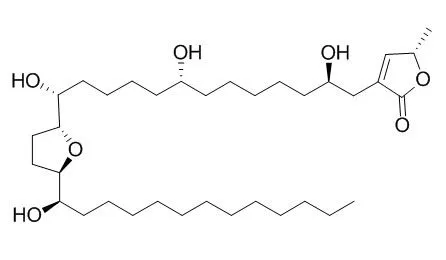| Description: |
Annonacin is mitochondrial complex I inhibitor, reported to be more toxic than rotenone to mesencephalic neurons; can cause significant cell death in various cancer cell lines. Annonacin induces growth arrest and apoptosis in ERα-related pathways in MCF-7 cells, attenuates MCF-7 xenograft tumor growth while inhibiting ERα, cyclin D1 and Bcl-2 protein expressions in nude mice. Annonacin-induced ATP depletion causes the retrograde transport of mitochondria to the cell soma and induces changes in the intracellular distribution of tau in a way that shares characteristics with some neurodegenerative diseases. |
| Targets: |
CDK | P21 | ERK | JNK | STAT | Bcl-2/Bax | Caspase | Estrogen receptor | Progestogen receptor |
| In vitro: |
| Neurotoxicology. 2012 Jan;33(1):53-8. | | Annonacin in Asimina triloba fruit: implication for neurotoxicity.[Pubmed: 22130466] | The acetogenin, Annonacin, from the tropical annonaceous plant Annona muricata, is a lipophilic, mitochondrial complex I inhibitor reported to be more toxic than rotenone to mesencephalic neurons. The temperate annonaceous plant Asimina triloba (pawpaw) is native to the Eastern United States and products are available online. This study determined whether Annonacin is in the pawpaw fruit pulp and whether it or the crude ethyl acetate extract is toxic to cortical neurons.
METHODS AND RESULTS:
Pawpaw extract was prepared by pulp extraction with methanol and liquid-liquid partitioning with ethyl acetate (EtOAc). Annonacin was isolated from the crude EtOAc extract via column chromatography using a gradient solvent system of increasing polarity. Mass spectroscopy, nuclear magnetic resonance and infrared spectroscopy were used to compare isolated material with synthetic Annonacin data and a natural Annonacin sample. Toxicity of isolated Annonacin and the total EtOAc extract was determined in primary rat cortical neurons using the MTT (3-(4,5-dimethylthiazol-2-yl)-2,5-diphenyltetrazolium bromide) assay. The average concentration of Annonacin in the fruit pulp was 0.0701±0.0305mg/g. Purified Annonacin (30.07μg/ml) and crude EtOAc extract (47.96μg/ml) induced 50% death of cortical neurons 48h post treatment. Annonacin toxicity was enhanced in the presence of crude extract.
CONCLUSIONS:
Pawpaw fruit contains a high concentration of Annonacin, which is toxic to cortical neurons. Crude fruit extract also induced neurotoxicity, highlighting the need for additional studies to determine the potential risks of neurodegeneration associated with chronic exposure to pawpaw products. | | J Neurosci. 2007 Jul 18;27(29):7827-37. | | Annonacin, a natural mitochondrial complex I inhibitor, causes tau pathology in cultured neurons.[Pubmed: 17634376] | A neurodegenerative tauopathy endemic to the Caribbean island of Guadeloupe has been associated with the consumption of anonaceous plants that contain acetogenins, potent lipophilic inhibitors of complex I of the mitochondrial respiratory chain.
METHODS AND RESULTS:
To test the hypothesis that Annonacin, a prototypical acetogenin, contributes to the etiology of the disease, we investigated whether Annonacin affects the cellular distribution of the protein tau. In primary cultures of rat striatal neurons treated for 48 h with Annonacin, there was a concentration-dependent decrease in ATP levels, a redistribution of tau from the axons to the cell body, and cell death. Annonacin induced the retrograde transport of mitochondria, some of which had tau attached to their outer membrane.
CONCLUSIONS:
Therefore, the Annonacin-induced ATP depletion causes the retrograde transport of mitochondria to the cell soma and induces changes in the intracellular distribution of tau in a way that shares characteristics with some neurodegenerative diseases. |
|
| In vivo: |
| Exp Neurol. 2014 Mar;253:113-25. | | Annonacin, a natural lipophilic mitochondrial complex I inhibitor, increases phosphorylation of tau in the brain of FTDP-17 transgenic mice.[Pubmed: 24389273] | Both genetic and environmental factors likely contribute to the neuropathology of tauopathies, but it remains unclear how specific genetic backgrounds affect the susceptibility towards environmental toxins. Mutations in the tau gene have been associated with familial tauopathies, while Annonacin, a plant-derived mitochondrial inhibitor, has been implicated in an environmental form of tauopathy.
METHODS AND RESULTS:
We therefore determined whether there was a pathogenic synergy between Annonacin exposure and the expression of the R406W-tau mutation in transgenic mice. We found that Annonacin exposure caused an increase in the number of neurons with phosphorylated tau in the somatodendritic compartment in several brain areas in R406W(+/+) mice as opposed to mice that had only the endogenous mouse tau (R406W(-/-)). Western blot analysis demonstrated a concomitant increase in total tau protein without increase in tau mRNA, but reduced proteasomal proteolytic activity in R406W(+/+), but not R406W(-/-) mice, upon Annonacin-treatment. Phosphorylated tau levels exceeded the increase in total tau protein, along with increased levels of different tau kinases, foremost a striking increase in the p25/p35 ratio, known to activate the tau kinase Cdk5.
CONCLUSIONS:
In summary, we observed a synergistic interaction between Annonacin exposure and the presence of the R406W-tau mutation, which resulted in reduced degradation, increased phosphorylation and redistribution of neuronal tau. |
|






 Cell. 2018 Jan 11;172(1-2):249-261.e12. doi: 10.1016/j.cell.2017.12.019.IF=36.216(2019)
Cell. 2018 Jan 11;172(1-2):249-261.e12. doi: 10.1016/j.cell.2017.12.019.IF=36.216(2019) Cell Metab. 2020 Mar 3;31(3):534-548.e5. doi: 10.1016/j.cmet.2020.01.002.IF=22.415(2019)
Cell Metab. 2020 Mar 3;31(3):534-548.e5. doi: 10.1016/j.cmet.2020.01.002.IF=22.415(2019) Mol Cell. 2017 Nov 16;68(4):673-685.e6. doi: 10.1016/j.molcel.2017.10.022.IF=14.548(2019)
Mol Cell. 2017 Nov 16;68(4):673-685.e6. doi: 10.1016/j.molcel.2017.10.022.IF=14.548(2019)